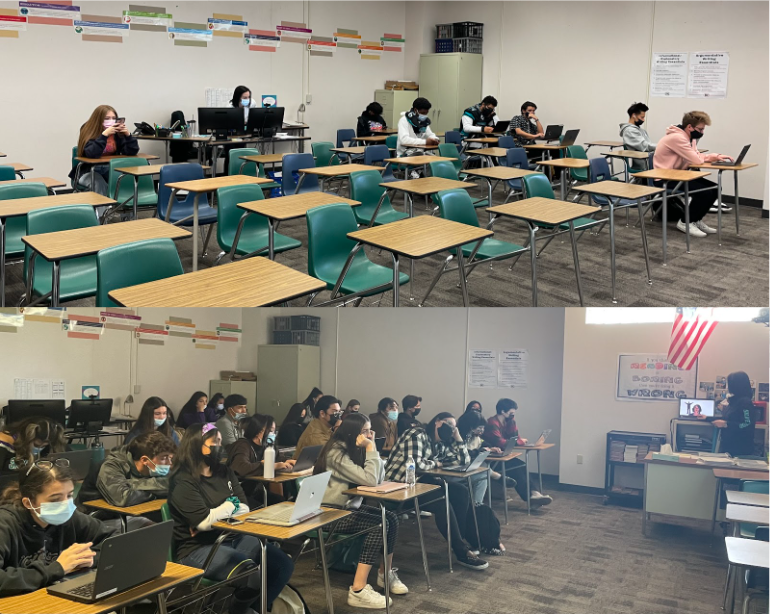Reducing class size inconveniences students
Schedule changes have some benefits, but ultimately aren’t much help
Silverado creates another class for English 12 Honors (classroom picture at the top) to free up some more space within each class.
November 22, 2021
It is common knowledge for teachers and educators that classrooms need improvement whether that is better materials or better teaching methods. Recently, Silverado went through a class reduction process to try to level overcrowded classrooms. This meant that students faced a small schedule change while some teachers would have a new class added to their schedule as a prep buyout. But is this where the story ends?
Assistant principal in charge of curriculum, Shirley Jimenez provided me with more details on the class reduction process. Jimenez said that the block scheduling we have, which offers four classes a day with eight total, has caused classes to be larger than a regular schedule with six classes a day. At the beginning of school this August, several core classes were too large with sizes in the 40s.
“In the past, our principal has been able to lower the class size by investing in adding classes for the overcrowded classes,” Jimenez explained. “Due to the lack of funds that we had to open the school with this fall, we had to make do with larger classes until the new budget was approved in October.”
The late budget is one reason schedules for students weren’t changed to help with class size until quarter 2. Usually, this process takes place in the first six weeks of school.
Jimenez added that the pandemic played a part in not being able to fully grasp what classes would look like. Jimenez began planning the schedule in November of 2020 when it was still uncertain whether we would come back in person full-time for the next school year. However, Jimenez made it clear that the lack of funding was the main cause of the delayed schedule changes, but also, that things appear to be much better.
“As of now, with the exception of several electives and some CTE courses, most classes are 38 students or below,” Jimenez said.
After this debriefing on the cause of the class reduction process, let’s take a look at how it was for students going through it.
The general opinion among students towards this class reduction process is that it has been very inconvenient. I, myself, who had a schedule change, was definitely a little annoyed about the process, considering I now have all of my core classes on the same day while at the same time, I lost the job of floor director for the school news by moving my Video Productions elective to another period.
The class I was moved to was also newly formed, which created more inconveniences. One problem was that we did not have access to any of the previous and current assignments since there was no class on Canvas for our new period.
A fellow senior, Alexander Benett, who had been transferred into the new English 12 Honors class as well, had his own fair share of inconveniences.
“After they switched me over, my assignments were locked for my previous class, and they hadn’t yet enrolled me into the new one,” Bennett said.
Bennett said he could not complete new assignments for that week of class, and that he could not access his grade in that class “for a solid week and a half.”
These little inconveniences were eventually addressed, so it was not that big of a deal, but more unaddressed problems come to the surface as we take a deeper look into other aspects of the process.
Silverado’s English 12 Honors was one of the nine other courses that were overcrowded, and English teacher Melissa Larosa had 44 students in just one of her classes. So did this change with the rescheduling?
“It started with 44, and now it has 40,” Larosa said.
After hearing this, I was shocked because I had assumed that class sizes would have gotten significantly smaller.
You could tell the same expectations were there for Larosa.
“I think it could have been done better if they have evened out the number of students in my classes,” Larosa said. “So in other words, instead of three very large classes, now I have three still large classes and one really small class (for English 12H).”
This truly made me question the purpose of the whole class reduction process because how could one of the most populated classes, which is also a core class, still be so large? Why even move students in the first place if not even one of the large classes turned to a smaller class? It just adds to the inconvenience of it if it can’t even serve its purpose in the first place.
In addition to core classes, there are more technical issues that have to be considered when it comes to more hands-on classes. A good example would be the Video Production department who has been having their own unique problems. CTE teacher Kevin Fiddler had some insight on how his classes have looked so far.
“My largest class has 28 students, which is a little tight but we are making it work,” Fiddler describes. “The rest of my classes are at 25 or less and work well.”
On the surface, this sounds pretty doable and doesn’t appear to be much of a problem, but Fiddler also adds that there are only 24 computers available in the broadcast classroom, and as a student from one of his Video Production III classes, I know that means that four students can not participate in certain assignments and also don’t even have a desk of their own.
This might not seem like much of a problem considering that it is only a small group of students, but I think that with the technical work done in that class, it’s unfortunate. It’s possible that four students can’t work on important assignments during class if all 28 are there, nor it is guaranteed they can work at home since the specialized tools or software they need may only be available at school.
Considering the type of teacher Fiddler is, I don’t think these four students’ grades would suffer, but it is obvious having less hands-on experience and practice will make learning harder than it needs to be.
Fiddler also gives us another reason as to why it is vital to keep his class small. “It’s simply access to equipment while maintaining safety within district fire codes and COVID mitigation,” Fiddler mentioned.
Both Fiddler and Larosa make it clear that this class reduction needed to be done for the benefit of the students’ learning, which I couldn’t agree with more. This is why I think it is so crucial that it is handled better next time.
I am certainly biased considering it was a bit inconvenient for me, but there are definitely many complications and unaddressed problems. Interviewing Jimenez on how she handled the process definitely allowed me to be a little more sympathetic towards how it went, but sadly, it just isn’t enough for me to believe that the process truly did the amount of good it was intended to.
The most important thing I learned after all that I discovered is that everyone involved truly wanted what was best for the students, and I think that is all we need to take from this as we go forward with decisions for the rest of the school year.

